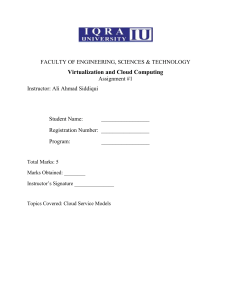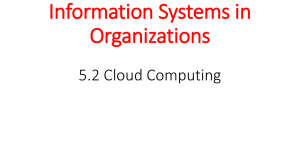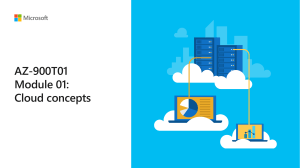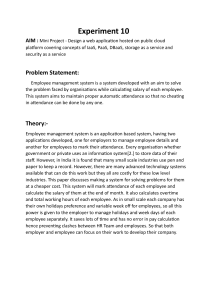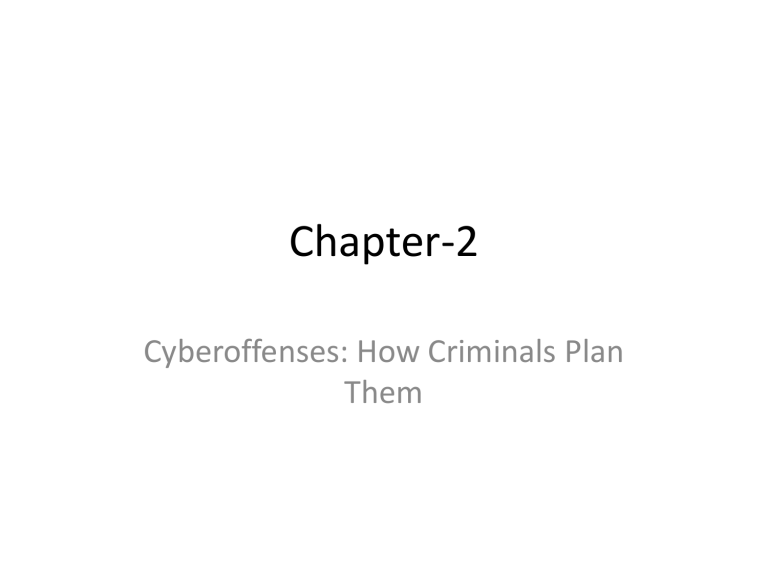
Chapter-2 Cyberoffenses: How Criminals Plan Them Objectives • Understand different types of attack • Overview of steps involved in planning cybercrime. • Overview of Social Engineering- What and how. • Role of Cybercafés in cybercrime. • Cyberstalking. • Botnets and Attack Vector. • Overview on Cloud Computing. Hackers, Crackers and Phreakers • Hacker: Hacker is a person with a strong interest in computers who enjoys learning and experimenting with them. Hackers are usually very talented, smart people who understand computers better than others. • Crackers: A cracker is a person who breaks into a computers. Cracker should not be confused with hackers. Some of their crimes include vandalism, theft and snooping in unauthorized areas. Hackers, Crackers and Phreakers • Phreaking: This is an infamous art of breaking into phone or other communication system. • Phreaking is the process of old age times which is used to hack telephone lines to get free long range calls. Attackers and their Profile Categories of Cybercrime • Cyber crimes can be categorized based on: – The target of crime and – Whether the crime occurs as a single event or as a series of events. Categories of Cybercrime • The target of crime • Crimes Targeted at Individuals: The goal is to exploit human weakness, these crimes include financial frauds, sale of non existent or stolen items, Copyright violation, harassment etc. Categories of Cybercrime • Crimes targeted at property: This include stealing mobile devices such as cell phone, laptop and PDAs, Removable media etc. • Crimes targeted at organization: Attackers use computer tools and the Internet to usually terrorize the citizens of a particular country by stealing the private information and also to damage the problems and files or plant programs to get control of the network and/or system. Categories of Cybercrime • Single Event of Cybercrime: It is the single event from the perspective of the victim. • Series of Events: This involves attacker interacting with the victims repetitively. For example attacker interacts with the victims on the phone and/or via chat rooms to establish relationship and then they exploit the relationship. How Criminals plan the attack How Criminals plan the attack • Criminals use many tools to locate the vulnerabilities of their target. The target can be an individual or an organization. Criminals plan active or passive plan. • In addition to active or passive categories attacks can be categorized as either inside or outside. Inside Attacker • An attack originating and/or attempted within the security perimeter of an organization is an inside attack; it is usually attempted by an “insider” who gains access to more resources than expected. Outside Attack • An outside attack is attempted by a source outside the security perimeter, maybe attempted by an insider and/or outsider, who is indirectly associated with the organization. It is attempted through the internet or a remote access connection. How Criminals Plan the Attack • Following phases are involved in planning cybercrime: – Reconnaissance (Investigation) – Scanning and Scrutinizing (Examining) the gathered information for the validity of the information as well as to identify the existing vulnerabilities. – Launching an attack. Reconnaissance • The literal meaning of “Reconnaissance” is an act investigation often with the goal of finding something or somebody to gain information about an enemy. • In the world of hacking reconnaissance phase begins with “Footprinting” – this is the preparation toward preattack. Footprinting gives vulnerabilities and provides a judgments about possible exploitation of those vulnerabilities. • An attacker attempts to gather the information in two phases: Passive and Active attack. Passive Attack • A passive attack involves gathering information about a target without his/her knowledge. • It can be as simple as watching a building to identify what time employees enter the building premises. • Network sniffing is an another means of passive attack where network traffic is sniffed for monitoring the traffic on the network- attacker watches the flow of data to see what time certain transaction take place and where the traffic is going. Active Attack • An active attack involves inquiring the network to discover individual host to confirm the information ( IP addresses, Operating System type and version and services on the network) gathered in the passive attack phase. • It involves the risk of detection and is also called “Rattling the doorknobs” or “Active reconnaissance” . • This provides confirmation to an attacker about security measures. Scanning and Scrutinizing Gathered Information • Scanning is a key step to examine intelligently while gathering information about the target. The objective of scanning are as follows: – Port Scanning: Identify open/close ports and services. – Network Scanning: Understand IP address and related information about the computer network systems. – Vulnerability Scanning: Understand the existing weaknesses in the system. TCP/IP Port Scanning Port Scanners • If an attacker knows a specific port is used, that port could be probed for weakness • Port scanner – Used to search a system for port vulnerabilities that could be used in an attack – Determines the state of a port to know what applications are running and could be exploited • Three port states: – Open, closed, and blocked Port Scanner Social Engineering • Social Engineering is a “technique to influence” people to obtain the information or perform some action. • A social engineer usually uses telecommunication or internet to do something that is against the security/ policies of the organization. • Social engineering involves gaining sensitive information or unauthorized access privileges by building inappropriate trust relationship with insiders. Social Engineering • The goal of a social engineer is to fool someone into providing valuable information or access to that information. • Social engineer studies the human behavior so that people will help because of the desire to be helpful, the attitude to trust people, and the fear of getting into trouble. Social Engineering Example • Maria, a customer service representative, receives a telephone call from someone claiming to be a client. This person has a thick accent that makes his speech hard to understand. Maria asks him to respond to a series of ID authentication questions to ensure that he is an approved client. However, when asked a question, the caller mumbles his response with an accent and the representative cannot understand him. Too embarrassed to keep asking him to repeat his answer, Maria finally provides him with the password. Social Engineering Example • The help desk at a large corporation is overwhelmed by the number of telephone calls it receives after a virus attacks. Ari is a help desk technician and receives a frantic call from a user who identifies himself as Frank, a company vice president. Frank says that an office assistant has been unable to complete and send him a critical report because of the virus and is now going home sick. Frank must have that office assistant’s network password so he can finish the report, which is due by the end of the day. Because Ari is worn out from the virus attack and has more calls coming in, he looks up the password and gives it to Frank. Ari does not know that Frank is not an employee, but an outsider who now can easily access the company’s computer system. Social Engineering Example • Natasha, a contract programmer at a financial institution, drives past a security guard who recognizes her and waves her into the building. However, the guard does not realize that Natasha’s contract was terminated the previous week. Once inside, Natasha pretends that she is performing an audit and questions a new employee, who willingly gives her the information she requests. Natasha then uses that information to transfer over $10 million to her foreign bank account Classification of Social Engineering • Human-Based Social Engineering : Human-based social engineering refers to person-to-person interaction to get the required/desired information. – – – – – – Impersonating an employee or valid user Posing as an important user Using a third person Calling technical support Shoulder Surfing Dumpster Diving Shoulder Surfing Shoulder Surfing • Shoulder surfing is using direct observation techniques, such as looking over someone's shoulder, to get information. • Shoulder surfing is an effective way to get information in crowded places because it's relatively easy to stand next to someone and watch as they fill out a form, enter a PIN number at an ATM machine, or use a calling card at a public pay phone. • Shoulder surfing can also be done long distance with the aid of binoculars or other visionenhancing devices. Dumpster Diving Dumpster Diving • In the IT world, dumpster diving refers to using various methods to get information about a technology user. • In general, dumpster diving involves searching through trash or garbage looking for something useful. • This is often done to uncover useful information that may help an individual get access to a particular network. • So, while the term can literally refer to looking through trash, it is used more often in the context of any method (especially physical methods) by which a hacker might look for information about a computer network. Classification of Social Engineering • Computer-Based Social Engineering: It refers to get the required/desired information using computer software/internet. For example sending a fake mail to a user and asking him/her to re-enter a password in a web page to confirm it. – Fake E-mail – E-mail attachment – Pop-up Windows Example Pop-up Social Engineering Statistics • As per Microsoft Corporation research in 2007 there is an increase in the number of security attacks designed to steal PI. According to FBI survey on average 41% of security related losses are direct result of employees stealing information from their company. Cyberstalking Cyberstalking • Cyberstalking has been defined as the use of information and communications technology, particularly the internet, by and individual or group of individuals to harass another individual or group of individuals. • Cyberstalking refers to use of internet and/or other electronic communication devices to stalk another person. • It involves harassing or threatening behavior that an individual will conduct repeatedly for following a person, visiting a person’s home and/or business place. Types of Stalkers • Online Stalkers: Stalker aim to start the interaction with the victim directly with the help of the internet (E-mail and chat rooms). They makes sure that the victim recognizes the attack attempted on him/her. Stalker may use a third party person to harass the victim. Types of Stalkers • Offline Stalkers: The stalkers may begin the attack using traditional methods such as following the victim, watching daily routine of victim, gather information of victim through internet etc. Cases Reported on Cyberstalking • The majority of cyberstlkers are men and majority of their victims are women. In many cases, the cyberstalker and the victim hold a prior relationship, and the cyberstalking begins when the victim attempts to break off the relationship, for example, ex-lover, exspouse, boss/subordinate and neighbor. How Stalking Works • • • • • Gathering Personal Information of the victim Establish a connection. Keep on sending repeated mail Posting personal information on web site Call victim (Harass/Blackmailing) Cybercafe and Cybercrimes • In past several years, many instances have been reported in India, where cybercafés are known to be used for either real or false terrorist communication. • Cybercrimes such as stealing of bank password and subsequent fraudulent withdrawal of money have also happened through cybercafés. Cybercafe and Cybercrimes • Survey in one of the metropolitan cities in India – Pirated Software are installed in computers – Antivirus are not updated – Several cafes have installed the software called “Deep Freeze” – Unwanted stuff are not blocked – Owners are not aware about cyber security/Law – Government/State Police (Cyber Cell Wing) do not seem to provide IT Governance guidelines to café owners Guidelines for Café owner • Maintain a register for Identity of the visitor. • The Identity of the visitor/User shall be established through Voter card, identity card, driving license, passport or PAN card. • If any activity of the visitor is suspicious the owner of the cybercafé should inform to the near by police station. Tips for Safety and Security • • • • • • • • Always Logout Stay with the computer Clear history and temporary files Be Alert Avoid online financial transaction Change Passwords Virtual Keyboard Security Warning Virtual Keyboard Botnet • Bot is an automated program for doing some particular task, often over a network. • In simple word, a Bot is simply automated computer program through which one can gain control of your computer by infecting them with virus • Your computer may be a part of botnet even though it seems working normally. Security Parameters • Use antivirus and anti- spyware and keep it up to date • Set the OS to download and install security patches automatically. • Use a firewall to protect the system from hacking attacks while it is connected on the internet. • Disconnect from the internet when you are away from your computer • Check regularly the folder in your mailbox • Take an immediate action if your system is infected. Attack Vector • An attack vector is a path or means by which an attacker can gain access to a computer or to a network server to deliver a payload or malicious outcome. • Attack vector enable attackers to exploit system vulnerabilities. Payload means malicious activity that the attack performs Attack Vector • To some extent attack vector can be protected using firewalls and antivirus but no method is totally attack proof. Zero-Day Attack • A zero day is a computer threat which attempts to exploit computer application vulnerabilities that are unknown to anybody in the world (i.e. undisclosed to the software vendors and software users). • A zero day attack is launched just on or before the first or “zeroth” day of vendor awareness. Zero Day Emergency Response Team (ZERT) • This is a group of software engineers who work to release non-vendor patches for zero day exploits. Attack Vector Example • • • • • • • • • Attack by E-Mail Attachments Attack by deception Hackers Heedless guests Attack of Worms Malicious macros Foist ware (Sneak ware) Viruses Attack by deception • Deception is aimed at the user/operator as vulnerable entry point. • Social engineering and hoaxes are other forms of deception that are often an attack vector. Heedless guests (Attack by Webpage) • Counterfeit websites are used to extract personal information. Such websites are very much like the genuine websites. Foist ware • Foist ware is the software that adds hidden components to the system cleverly. • Spyware is the most common form of foistware. Cloud Computing • Cloud computing is internet based development and use of computer technology. • Characteristics of cloud computing are: – It is sold on demand – It is elastic in term of usage – The service is fully managed by the provider • Prime area of risk in cloud computing is protection of user data. Why Cloud Computing • Applications and data can be accessed from anywhere at any time. Data may not be held on a hard drive on one users computer. • It could bring hardware cost down. • Organization do not have to buy a set of software license for every employee and the storage devices take up space. Why Cloud Computing • Organization do not have to rent a physical space to store servers and database. Storage and digital devices take up space. • Organization would be able to save money on IT support Types of Services • Infrastructure-as-a-Service (IaaS) • Platform-as-a-Service (PaaS) • Software-as-a-Service (SaaS) Infrastructure-as-a-Service (IaaS) • IaaS businesses offer services such as pay-as-you-go storage, networking, and virtualization. • IaaS gives users cloud-based alternatives to on-premise infrastructure, so businesses can avoid investing in expensive on-site resources. • Advantages: • Maintaining on-premise IT infrastructure is costly and labor-intensive. • It often requires a significant initial investment in physical hardware, and then you will probably need to engage external IT contractors to maintain the hardware and keep everything working and up-to-date. • With IaaS, you can buy what you need, as you need it, and purchase more as your business grows. Infrastructure-as-a-Service (IaaS) • IaaS solutions are highly flexible and highly scalable, and you can replace it whenever you need without losing money on your initial investment. • Another advantage of IaaS is it puts control over the infrastructure back in your hands. • You no longer need to place faith in an external IT contractor; you can access and oversee IaaS platforms yourself if you wish Infrastructure-as-a-Service (IaaS) • A good example of IaaS is AWS EC2. • EC2 provides scalable infrastructure for companies who want to host cloud-based applications. • EC2 users do not own the physical servers; AWS provides virtual servers. • So users only pay for the usage of the servers, saving them the cost (and associated ongoing maintenance) of investing in physical hardware. Platform-as-a-Service(PaaS) • A PaaS vendor provides hardware and software tools over the internet, and people use these tools to develop applications. PaaS users tend to be developers. • PaaS Advantages: • PaaS is primarily used by developers who are building software or applications. • A PaaS solution provides the platform for developers to create unique, customizable software. • This means developers don’t need to start from scratch when creating applications, saving them a lot of time (and money) on writing extensive code. • PaaS is a popular choice for businesses who want to create unique applications without spending a fortune or taking on all the responsibility. Platform-as-a-Service(PaaS) • A good example of PaaS is AWS Elastic Beanstalk. • Amazon Web Services (AWS) offers over 100 cloud computing services such as EC2, RDS, and S3. • Most of these services can be used as IaaS, and most companies who use AWS will pick and choose the services they need. • That’s where AWS Elastic Beanstalk comes in: it works as another layer on top of the infrastructure services and automatically handles the details of capacity provisioning, load balancing, scaling, and application health monitoring. • Software-as-a-Service(SaaS) • SaaS platforms make software available to users over the internet, usually for a monthly subscription fee. • SaaS Advantages: • With SaaS, you don’t need to install and run software applications on your computer (or any computer). • Everything is available over the internet when you log in to your account online. • You can usually access the software from any device, anytime (as long as there is an internet connection). • The same goes for anyone else using the software. All your staff will have personalized logins, suitable to their access level. • You no longer need to engage an IT specialist to download the software onto multiple computers throughout your office or worry about keeping the software on every computer up-to-date. • It’s all taken care of in the Cloud. Software-as-a-Service(PaaS) • Most SaaS providers operate a subscription model with a fixed, inclusive monthly account fee. • You know exactly how much the software will cost and can budget accordingly, without worrying about hidden surprises. • BigCommerce is an example of a SaaS ecommerce platform. • BigCommerce provides complete shopping cart software, as well as hosting infrastructure to the user, allowing businesses to create an online shop within minutes without worrying about coding, hosting, or software. • Risks associated with Cloud Computing Environment • • • • • Elevated user access Location of Area Segregation of Data Recovery of Data Long term Viability
